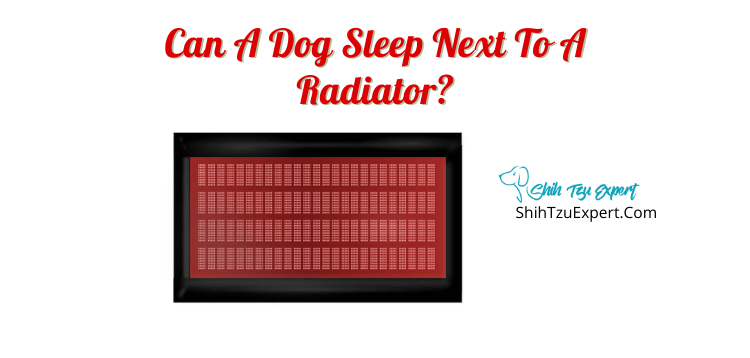Every time winter comes around, there is a lot of questioning by dog owners about whether it is safe for dogs to sleep next to a radiator. Will they burn themselves? Where in the house is safe for them to sleep? What should you set your thermostat to?
Can A Dog Sleep Next To A Radiator?
It is perfectly okay for your dog to sleep near to the radiator. If they are right next to it, this may cause burns on their skin. However, they need to be near the radiator, particularly during the winter, so they do not get too cold during the night.

Can Dogs Burn Themselves On Radiators?
It is completely possible for dogs to burn themselves on a radiator. This type of burn is called a thermal burn and is also commonly caused by fire, heating pads/blankets, hot car parts, tools and grills.
Can I Setup My Dog’s Bed/Crate Near A Radiator?
It is okay to put your dog’s bed or crate near a radiator as it is important to keep your dog warm and the best way to do this is to put whatever they are sleeping in relatively near a radiator.
You shouldn’t put their bed or crate too close to the radiator as they will get too hot; however, it is still important to keep where they are sleeping near a source of heat (such as a radiator) so they do not get too cold.
Even though you need to keep their bed or crate near a radiator so they can feel the warmth of it, you need to bear in mind that at some point the heating will go off and this will leave your furry friend feeling the cold, so you should also provide another source of heat,such as a heat pad, to keep them warm throughout the night.
Are Radiators Safe For Dogs?
Radiators can be safe for dogs as long as they do not get too close to it. If your dog gets too close to a radiator, this could leave them with burn marks; particularly if their paws touch a hot radiator. The best way to protect your dog from the heat of a radiator is by purchasing a radiator cover. Buying one means your dog is able to get right up close to a radiator (and even touch it) without causing any harm to themselves.
Can A Dog Crate Go Next To A Radiator?

Whilst a dog crate is able to go near a radiator, it cannot go next to a radiator. This is because by placing the crate next to a radiator, this can get too hot for your furry friend. Even if you believe it to be too cold for your pet pooch (which also is not good for them), putting them next to the radiator can be dangerous as they may overheat or get burn marks on their skin.
Why Does My Dog Sleep Next (Or In Front) To The Radiator?
Dogs love any and all heat sources, particularly when it is cold outside and they want to warm themselves up. They find the heat quite comforting and so love to snuggle up next to the radiator; particularly if there are no humans they can do that with.
Dogs are able to tolerate heat a lot more than we can, so if you are finding the room slightly too warm and you are not sat near the radiator but are concerned your dog may get too hot, it is more than likely they will not as dog’s have a higher basal body temperature than we do.
However, it is still important to keep an eye on your dog if they are sleeping right next to the radiator. We all know dogs start panting when they get too hot, so if your dog starts doing this, either turn down the heating or try and move your dog away from the radiator.
Is It Ok To Leave A Puppy In Front Of A Radiator?
Your puppy should be perfectly okay sitting in front of a radiator.
If dogs get too hot and they are able to move, they will move to a much cooler area to cool down.
If you are worried about your puppy getting too warm by being next to the radiator, make sure to keep an eye on them. If they start panting or start showing any other signs of being too hot, move them away from the radiator and into a cooler spot.
Why Does My Dog Sit Staring At The Hot Radiator?
Your dog is most probably sat staring at the hot radiator because they enjoy the heat and warmth that comes from it. Particularly when they have just been out for a walk on a cold day, all they want to do is be near the radiator.
What Is The Best Thermostat Setting For Your Dog When You’re Not At Home?
If you are not at home but your dog is, you should not set your thermostat any lower than sixty degrees fahrenheit (fifteen degrees celsius). If your dog is small, young, or sick, you should set the temperature slightly higher than if they are big, old, or healthy.
There are a variety of other factors you need to take into consideration when thinking about what temperature you need to leave your thermostat at, including their coat type, size, body fat, age, and health.
If your dog has a thick, long coat, this means they should be more tolerant to the cold and can overheat quicker than humans. However, if your dog has thin fur, short fur, or is hairless, they retain body heat less, so will need the temperature to be higher.
If you have a small dog, they will get cold much quicker than larger dogs. Small dogs have a higher surface-area-to-volume ratio, so have more skin to lose body heat through.
If your dog is overweight, this means they have a thicker layer of fat to insulate and protect them against the cold, so they will not need the heating on as high.
If your dog is a puppy or an older dog, or they have acute infections or chronic joint conditions, this means they will need the heating to be at a higher temperature than a dog without any illnesses or who is between either of these ages.
Can Central Heating Affect Dogs?
There are a variety of ways central heating can affect dogs, including the temperature being too high.
You may think that your pet pooch is too cold and so turn the heating up, but the reality is that dogs are traditionally outdoor animals, so can tolerate the cold a lot more.
This also means you can afford to not keep your heating on if you go out for a few hours (which can also help save you a bit of money), as long as you leave them some blankets so they can keep themselves warm if needs be, they’ll be fine.
However, this can all depend on the breed of your dog. For example, if you have a husky, they are much more likely to prefer the cold compared to a whippet. You should always take the breed of your dog into consideration when deciding what temperature to set the central heating at.
Higher temperatures can also cause your dog’s skin to become dry and uncomfortable due to a decrease in humidity. This is important to bear in mind as none of us want to make our pet pooches feel uncomfortable.
Can A Heater Make A Dog Sick?
It is entirely possible for a heater to make your dog sick, particularly as when the heater gets hotter, this is what can lead to your pet pooch becoming dehydrated, amongst other health issues.
As well as becoming dehydrated, your heater can also cause your dog to vomit and in some cases can even lead to death.
This is why it is important for you to keep an eye on your furry friend whenever you have the heating on, make sure they do not get too near the heater/radiator, give them plenty of water to drink and if you notice they are becoming too hot, turn the heating down to cool them down.
Where Should Dogs Sleep At Night?
At night, it is best to keep your dog either in their bed or crate that is still somewhat close to a radiator, particularly during the winter months, so that they are still able to keep warm whilst not becoming overheated.
We all only ever want to be comfortable, particularly when we are in bed going to sleep, and the same goes for dogs.
It’s always worth remembering that dogs feel the heat easier than we do, so you can always turn the heating down an extra few degrees without having to worry about them getting too cold overnight.
Where Should I Place My Dogs Bed/Crate?
Where you place your dogs bed should depend on their age, lifestyle and personality. This factor also depends on whether your dog is an adult or a puppy.
If you have a puppy, you should keep them in the same room as you, allow them to sleep next to you in a crate and then gradually get them into the habit of sleeping elsewhere in the house.
Adult dogs are completely different. They are able to sleep anywhere in the house, particularly where they feel most comfortable.
Where Is The Best Place For A Dog To Sleep At Night?
The ideal place for a dog to sleep at night is somewhere that is enclosed, warm and stable, not in the middle of a busy area, and is within earshot of you and your family.
Dogs need to feel safe and secure with their surroundings and if this does not happen, they will not sleep. It may be best to place their bed/crate in the corner of the room or under an open staircase. Basically, they need to be anywhere that surrounds their bed.
You also need to put them in an area of your house that is warm and stable, whilst bearing in mind that the temperature will get colder overnight, so it needs to be somewhere that will either remain relatively the same temperature the whole night or you can put a heat pad nearby.
Their bed/crate should also be in a quieter area as even though they like to be around people, they also need to be in a quiet space to be able to go to sleep. This means not putting it in the hallway or in the same area as where they eat, as this could cause them to get too excited.
As mentioned above, dogs enjoy being around people, but their sleeping place should be a quiet place. However, they also prefer to be in earshot of people when they are sleeping, which could be in a bedroom, particularly as bedrooms tend to remain the right temperature throughout the night for both dogs and humans.
References
https://canna-pet.com/dog-burns-scalds-a-helpful-guide/
https://www.pets4homes.co.uk/pet-advice/where-is-the-best-place-to-put-your-dogs-bed.html
Great Routes To A Dog Friendly Home
https://wagwalking.com/behavior/why-do-dogs-sit-in-front-of-heaters
https://www.petforums.co.uk/threads/is-puppy-ok-in-front-of-radiator.205650/
https://www.aireserv.com/about/blog/2018/april/what-is-the-ideal-house-temperature-for-dogs-and/
![6 Best Dog Treadmills for 2023 [Buyer’s Guide] 6 Best Dog Treadmills for 2023 [Buyer’s Guide]](https://shihtzuexpert.com/wp-content/uploads/2019/04/Best-Dog-Treadmills-1.png)
![Shih Tzu Poodle mix [Your complete guide to Teddy bear dog | Shih Poo | Shoodle or Pooshi] Shih Tzu Poodle mix [Your complete guide to Teddy bear dog | Shih Poo | Shoodle or Pooshi]](https://shihtzuexpert.com/wp-content/uploads/2020/06/Are-You-a-Good-Match-for-a-Shih-Poo.jpg)

![12 Best Dog Foods for Toy Breeds [Buyer's Guide] 12 Best Dog Foods for Toy Breeds [Buyer's Guide]](https://shihtzuexpert.com/wp-content/uploads/2019/05/3-5.jpg)
